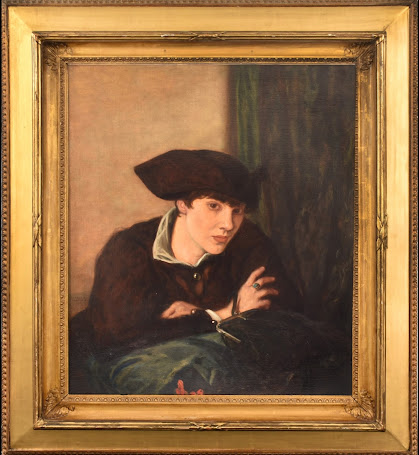Searching online for undiscovered Ricketts material, I stumbled across an intriguing title a while ago:
'Ricketts and Cézanne', letter by D.S. MacColl, New State[s]man and NationThe catalogue description by Trinity College library in Cambridge indicates that this undated clipping is in the ‘Papers of Clive Bell', numbered Bell/5/82 [see here for a link to the catalogue description].
We know that Ricketts stopped writing articles for The Burlington Magazine when Roger Fry became editor in 1909, mainly because the latter was a champion of Cézanne and the Post-Impressionists. Who, therefore, would not be interested in an article by a third art critic and Cézanne aficionado, Clive Bell, on this very subject: ‘Ricketts and Cézanne’?
I, at least, was, but I had to find it first! How do you trace an undated article other than by getting the volumes on your desk and flipping through year after year? (As far as I know, there is no digital version of The New Statesman and Nation.)
I finally found it in the 6 January 1940 issue of The New Statesman and Nation. However, I was disappointed. Firstly, because it turned out not to be a long and thorough article, but a short letter to the editor, and, secondly, because neither Ricketts nor Cézanne are mentioned in it. The note is entirely about yet another art critic, D.S. MacColl (1859-1948).
 |
| Clive Bell, 'Ricketts and Cézanne', The New Statesman and Nation, 6 January 1940 |
The letter turns out to be the conclusion of a short series of publications in the magazine, its title taken from the previous episode: a letter from D.S. MacColl published on 30 December 1939.Clive Bell responded to a single sentence in a nearly sixty-line piece:
Your vivaciously independent Weekly is in no danger of lacking readers, but in matters of visual art is notoriously a tied house, an estimable family party with its poor dependents, a side-chapel tirelessly tintinnabulated by Mr. Bell.(D.S. MacColl, 'Ricketts and Cézanne', The New Statesman and Nation, 30 December 1939, p. 959)
Although the magazine's editor had already felt compelled to make it clear that it was truly independent of any art-critical coterie, Bell also felt he had to add that his integrity as an art critic should not have been questioned by MacColl, while, in the same vein, vaunting a few more blows, saying for example that it was unfortunate that MacColl was currently guided by only one emotion: rage.
In his article of 30 December 1939, MacColl indeed took a firm line against Raymond Mortimer (1895-1980), an art and literary critic, who on 16 December 1939 had published a review of Ricketts's posthumously published Self-Portrait, which had prompted a first letter from MacColl in the issue of 23 December which was followed by a short answer by Mortimer which, again, enraged MacColl whose second letter started with these lines:
Sir, - Yes, Ricketts's negative estimate of Cézanne, quoted by Mr Mortimer, is nearer the mark than the Meier-[G]raefe, Vollard legend, swallowed whole by Roger Fry and his âmes damnées, and epitomised in Mr. Mortimer's words "one of the greatest artists that the world has ever known."
(By the way, that phrase does not appear in this series of reviews and responses.)
 |
Paul Cézanne, 'La Montagne Sainte-Victoire vue de Bellevue' (c.1885)
[Barnes Foundation, Philadelphia] |
In his review (16 December 1939), Mortimer had written:
While he considered Renoir a vulgar sensualist, Cézanne mentally deficient and Matisse an imposter, he delighted in the insipidity of Puvis.
MacColl remarked (on 23 December 1939):
Ricketts as a critic, became only too "Catholic" in his latter days; like all of us, he had his blind spots [...] and his estimate of Cézanne, and of Renoir, for whom on due occasion he had an enthusiastic but discriminating admiration, are more likely to be those of the future than the exaggerated views which Mr. Mortimer has adopted.
Ricketts had denounced Cézanne's art as experimental and, as he argued in Pages on Art (1913):
All these 'experimentalists' are united in one fault; they are over-confident; they forget that the place for the experiment is the studio; it is not an aim but a means.
In his second letter (30 December 1939), MacColl took an anti-Semitic turn, apparently assuming that Ricketts had Jewish roots:
Ricketts was by no manner of means infallible: he did not appreciate, poor devil, the majesty of Handel, and did adore the tinsel of Gustave Moreau. That touches the nadir of his Jewish strain and taste, whose zenith was a passion for all the gems on Aaron's breastplate and their setting.
These are incomprehensible words that say more about that period in our history than about Ricketts, not least because these phrases were not contradicted by other letter writers in The New Statesman and Nation.
[Thanks are due to Jeroen Vandommele for providing an image of the Bell letter.]








